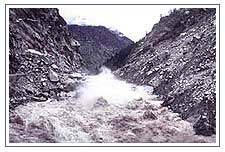The Sutlej has its source near the holiest of lakes - the Mansarovar in
Tibet. It is the fastest of the Himalayan Rivers and the only one that takes
on the Himalayas head on.

From the source the Sutlej flows northwest parallel to the Himalayan range
looking for a gap to penetrate through. After a run of 300-km, it finds one
at Shipkila, just short of Leo Pargial mountain. Like maneuvering army, it
then makes a full ninety-degree sweep and cuts through the Zanskar range,
and offshoot of the Greater Himalayan. As it emerges out of the Zanskar
range it is joined by the Spiti River.
Now, reinforced by the Spiti and other small and big glacial streams, the
Sutlej makes a diagonal thrust through the Great Himalayan Range, cutting a
deep gorge with the sacred Kinner Kailash massif on its left and the
Mainrang range to its right. Battle muddied through 60-km of gorge, at
Karcham, it is welcomed by the crystal clear blue waters of the Baspa River.
The Baspa drains the Sangla valley, considered to be the most beautiful
valley in the Himalayas.
A Dangerous Turn
It is from Karcham for about 25-km that the Sutlej is
in its most ferocious and challenging moods-boulders, rocks and rubble are
tossed around in mighty foaming rapids, the loose strata of the ranges on
the flanks further adding to the debris. It is in this form, 4-km down river
from Wangtu, that it meets the "Pick-Up Dam" for the tunnel of the
famous Nathpa Jhakri Hydel Project.
After this, the Sutlej makes a 200-km dash till finally it loses its
momentum and mingles with the backwaters of the Bhakra Dam. Prior to
construction of the Bhakra Dam the Sutlej was most feared for the tremendous
damage and misery it caused when in flood.
Energy Source Of The Himalayan Regions
The fast flow with just the
right amount of water makes the Sutlej and its tributaries the "Power
House of the Himalayas". The Hindustan-Tibet Road running along the
banks of the river gives accessibility. The hydel potential of the river is
being harnessed by construction of storage dams in its lower sections and
through Run of the River projects in its faster sections.
The 'Run of the river" schemes involve erection of a weir/ dams
with desalting tanks for storing sufficient water to ensure continuous
supply through a tunnel/ open channel to a point above the power house site
and then given a drop to operate the turbines. The bigger the drop, more the
force and with it power. At places like the 'Baspa stage I" water
is again channelised through a tunnel to operate another power station thus
avoiding the cost of constructing another weir / dam and desalting chambers.
In the final operating stages of the hydel projects, the protection of
existing forests and plantation of new one will be critical. The total hydel
power potential in Himachal Pradesh is assessed to be 20,000 mw of which
about 50% is from the Sutlej basin. In the absence of green covering in the
catchment area, the Sutlej will remain the "Untamed Himalayan power
house".


